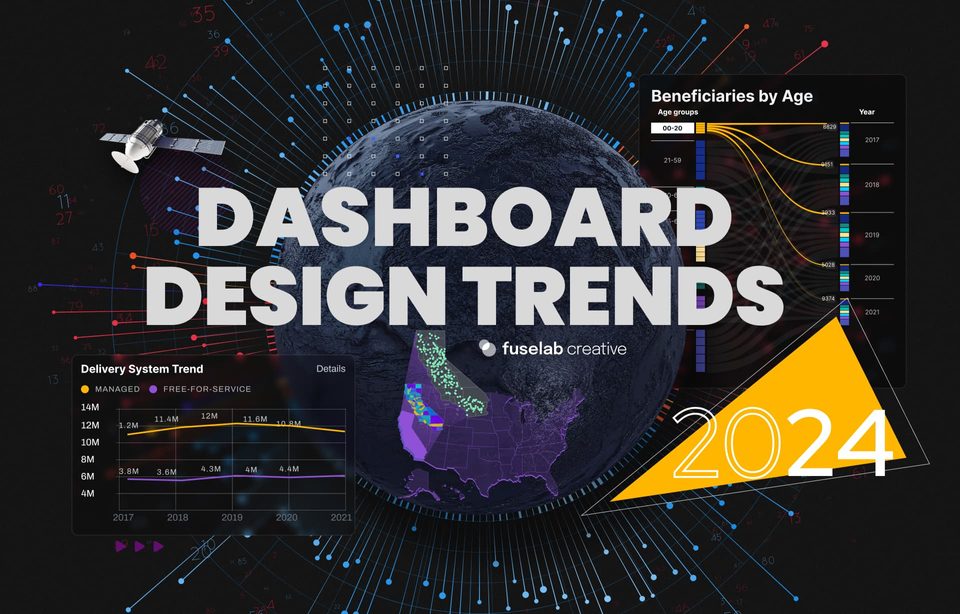Dashboard Design Inspiration

In today’s tech-facing world, dashboards and other digital interfaces are a fundamental part of our lives.
We see dashboards in practically all the tech we use. Your phone, the ATM, the grocery store checkout, even on-demand TV – it’s all dashboard-driven.
We find ourselves continuously inspired by how dashboard interface design inspiration can be found almost anywhere you look. Take a look at a recent example of dashboard design from FuseLab Creative.
Given the evolution of dashboard design, determining what effective dashboard design inspiration looks like in 2019 is an important question.
To put this importance into perspective, Americans spend up to 10 hours a day connected to a screen.
Whether a phone, tablet or some Internet-of-Things (IoT) device, that’s a lot of time. This is what makes dashboard design so critical in our world. And finding the best dashboard design inspiration examples is a critical daily pursuit. The good news is, that you only have to turn over in bed and pick up your phone.
Effective digital interfaces are the hallmark of any worthwhile product or service. Without intuitive design and controls, you immediately lose your audience.
If you’re in the planning stages, read on for some key UI dashboard design inspiration. We will walk you through several ideas to make your interfaces better for your users.
Unlocking the Path Between Users and Design
Think back to a time when you dealt with a poor digital interface or dashboard. Do you remember how frustrating it was to use it? Do you remember how much less willing you were to keep using that product?
These are the reasons why you need an effective dashboard for your users.
Truly worthwhile digital interfaces seamlessly connect a platform with users. This has become even more important with the rise of Internet (IoT) connectivity. According to research from TechJury:
- By 2025, more than 64 billion IoT devices will be used across the world.
- 63% of IoT devices will be within consumer electronics by 2020.
- In 2018, 80% of senior business executives noted the critical nature of IoT in their industries.
The world is changing, and that change involves the connectivity between people and tech. As we scale this idea forward, we need to make sure this connection positively changes our lives. The best way to achieve that goal is through user-centered design principles.
Looking at Dashboard Design Through a Child’s Eyes
Usable design in your dashboard or interface must always lead with simplicity in mind. The best dashboard page design inspiration almost always stems from some simple system or module that opens our eyes to a new construct. Nobody likes a complex, overwhelming system. This holds especially true for first-time users.
The best way to steer clear of developing overly complex systems is to take yourself back in time. Think back to the perspective of a child. What would a tech-aware child expect to see with a dashboard when she picks it up for the first time?
This is where you ought to begin to find your dashboard design inspiration. Think like a kid. The UI dashboard design for a child is undoubtedly going to produce a fluid and simple experience for an adult. Ask yourself a few questions from this perspective:
- How do I make this UI intuitive?
- How can I simplify a (potentially) complex system
- How do I best connect functionality to users achieving their goals in the system?
In most cases, simpler is better. Simple designs that lead users toward their goals faster will always yield better user satisfaction.

Relevance, Insight, and Attention
The best creative dashboard design inspiration comes from right where you’d expect – your users. Intuitive UIs take their users into account first and foremost.
After all, they’re the ones engaging with what you’ve made. Here are a few methods to connect your design with your customers:
- Look Outward for Inspiration: Take a look at successful effective dashboard designs from other companies – especially your competition. See what people are saying about the designs. Identify what works best. And connect those ideas with your own designs.
- Listen to Feedback: If you’re updating a current dashboard, take user feedback to heart. Assess the biggest complaints you’ve seen about prior iterations. Make changes that reflect what your users want.
- Envision the Future: Inspiration often comes when we look forward – not backward. Think about where you’d like your professional dashboard design to go in the future. Orient your design around those goals to shift potential ideas into real-world
Driving Your Car (or Flying a Plane) for Inspiration
Blindly following the slogan “simpler is better” can only go so far. What if your dashboard controls something extremely complex? What if you need many more components on-screen to effectively achieve user goals?
To resolve these problems, try thinking about your UI like you would a vehicle. When driving a car, for example, your goal is to get yourself safely and comfortably from point A to point B.
Everything on your dashboard is designed to support that goal. Now think about something more complex like an airplane dashboard.
If you’re just a car driver, an airplane’s dashboard design is way too much to handle.


Fuselab - the leading interface and dashboard design agencies in the country.
Every device we use, from our phones to market self-checkout screens requires an interface/dashboard design. Fuselab Creative began developing a focus on this unique environment to give clients an uncommon level of expertise and historical knowledge.

